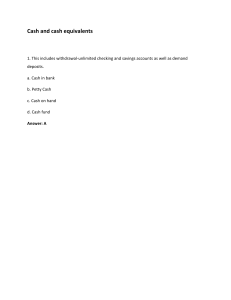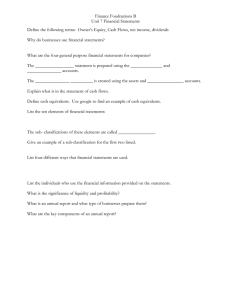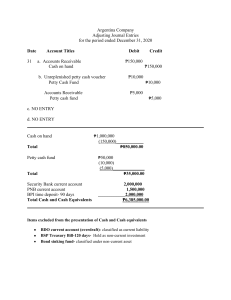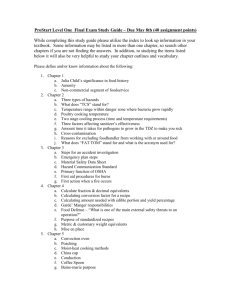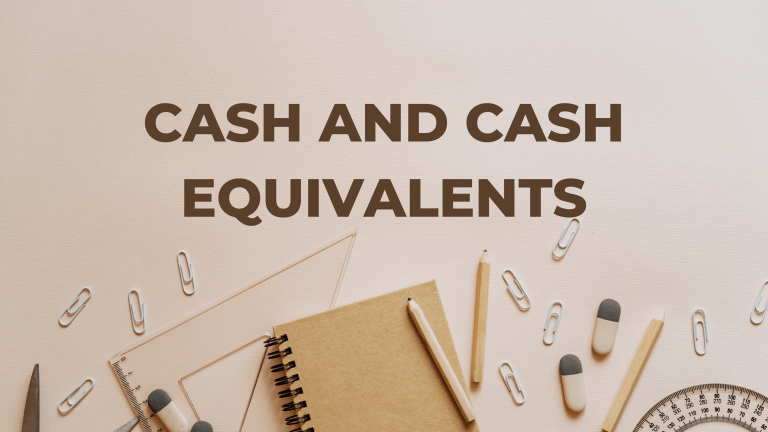
CASH AND CASH EQUIVALENTS WHAT IS CASH? Cash includes money and any other negotiable instrument that is payable in money and acceptable by the bank for deposit and immediate credit. RECOGNITION Since there is no specific standard governing cash and cash equivalents, the related standard is ". The only guidance is found in PAS 1, paragraph 66, which provides that "an entity shall classify an asset as current when it is cash or a cash equivalent unless it is restricted from being exchanged or used to settle a liability for at least twelve months after the end of reporting period." In conclusion, to report an item as part of cash, it should be UNRESTRICTED IN USE. MEASUREMENT ITEM MEASUREMENT Cash in local currency at face value Cash in foreign currency at face value but translated to Philippine Peso using closing rate at year-end Cash in closed bank or banks in bankruptcy estimated realizable value COMPOSITION OF CASH Category Items Part ofcash? Coins and currencies Cash on Hand Checks ✔ Normal customer'schec ks ✔ Cashiers',Mana gers' & Travelers' check ✔ Undelivered & Post-dated checks Stale checks Other instruments Classification drawn by the entity ✔ revert to payable drawn by another person or entity x receivable drawn by the entity ✔ revert to payable / other income drawn by another person or entity x receivable Money order ✔ Bank drafts ✔ COMPOSITION OF CASH Category Cash in bank Items Part ofcash? Demand deposit (Non-interest bearing) ✔ Savings deposit (Interest bearing) ✔ Escrow deposit (Interest bearing) x long-term investment Time deposit (Interest bearing) x cash equivalent unrestricted/info rmal *if silent ✔ restricted/forma l x restriction is more than 12 months -long-term investments restriction is 12 months or less - short- term investments General rule & if silent x current liability exceptions: (a) 2 or more accounts with the same bank (✔) offset from other bank accounts Compensating balance Bank overdraft Classification (b) immaterial offset from other cash accounts COMPOSITION OF CASH current asset ✔ for asset acquisition non-current asset X Examples: change fund; payroll fund, revolving fund, petty cash fund; travel fund ✔ current liability Examples: interest fund; dividend fund; tax fund ✔ non-current liability Examples: pension fund; contingent fund; insurance fund; bond sinking fund x for use in operations long-term investment Cash fund for settlement of liabilities long-term investment ACCOUNTING FOR PETTY CASH FUND Petty cash fund is money set aside to defray relatively small amount of cash disbursements. Petty cash fund may be accounted for using the following methods: IMPREST FUND SYSTEM FLUCTUATING FUND SYSTEM Summary of Journal Entries WHAT ARE CASH EQUIVALENTS? PAS 7, paragraph 6, defines cash equivalents as short-term and highly liquid investments that are readily convertible into cash and so near their maturity that they present insignificant risk of changes in value because of changes in interest rates. RECOGNITION Only debt instruments acquired within 3 months or less before their maturity date can qualify as cash equivalents. Note: Equity securities cannot qualify as cash equivalents since they do not have maturity date, except redeemable preference shares (with mandatory redemption) that are acquired 3 months before their redemption date can qualify as cash equivalents. COMPOSITION EXAMPLES OF CASH EQUIVALENTS ARE: Time Deposit Money market instrument or commercial paper Treasury Bills NOTE: 1. IF AN ITEM CANNOT BE INCLUDED AS CASH EQUIVALENT BECAUSE IT DID NOT QUALIFY THE CUT-OFF TIME PERIOD, IT WILL BE CLASSIFIED AS INVESTMENTS, SHORT-TERM OR LONG-TERM, DEPENDING ON THE PERIOD UP TO MATURITY. 2. IF THE PROBLEM IS SILENT WITH REGARDS TO THE ABOVE ITEMS (A-C), THEY ARE CLASSIFIED AS CASH EQUIVALENTS. BANK RECONCILIATION A bank reconciliation is a statement which brings into agreement the cash balance per book and cash balance per bank. It is usually prepared monthly because the bank provides the depositor with the bank statement at the end of every month. The source document for bank reconciliation is the bank statement coming from the bank. A bank statement is a monthly report of the bank to the depositor showing the cash balance per bank at the beginning, the deposits acknowledged, the checks paid, other charges and credits and the daily cash balance per bank during the month. Actually, the bank statement is an exact copy of the depositor’s ledger in the records of the bank. FORMS OF BANK RECONCILIATION 1. Adjusted balance method - Under this method, the book balance and the bank balance are brought to a correct cash balance that must appear on the balance sheet. 2. Book to bank method - Under this method, the book balance is reconciled with the bank balance or the book balance is adjusted to equal the bank balance. 3. Bank to book method - Under this method, the bank balance is reconciled with the book balance or the bank balance is adjusted to equal the book balance. NOTE: The above methods are not independent methods, they are inter-related. For a simpler computation, the suggested solution format below is based on the adjusted balance method. Note: Errors are to be added or deducted by the party who committed the error based on its nature. The following is a guide on the treatment of the errors. Nature of the Error Understatement Overstatement Error on receipt (collection) Added Deducted Error on disbursement (payment) Deducted Added Based on the guide above, we can say the receipts or collections directly affect cash while disbursements or payments inversely affect cash. Proof of Cash A proof of cash is an expanded reconciliation in that it includes proof of receipts and disbursements. This approach may be useful in discovering possible discrepancies in handling cash particularly when cash receipts have been recorded but have not been deposited. In answering proof of cash, always bear in mind that it is just expanded bank reconciliation. Follow these basis steps in answering proof of cash questions. Step 1: Analyze the beginning and ending column of the format as if it is bank reconciliation. Step 2: Analyze the middle columns based on the nature of the item. THANK YOU
